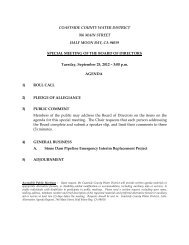Lower Pilarcitos Creek Groundwater Basin Study - Coastside ...
Lower Pilarcitos Creek Groundwater Basin Study - Coastside ...
Lower Pilarcitos Creek Groundwater Basin Study - Coastside ...
Create successful ePaper yourself
Turn your PDF publications into a flip-book with our unique Google optimized e-Paper software.
Hydrogeologic Setting<br />
The hydrogeologic setting provides the context for understanding the three study<br />
areas of the watershed, groundwater basin, and proposed wellfield. The setting<br />
includes climate, historic land use and land use planning, groundwater<br />
development and wells, soils, streamflow, geology, and hydrogeology. Three<br />
hydrogeologic cross sections are presented, two roughly parallel to the shoreline<br />
and one parallel to <strong>Pilarcitos</strong> <strong>Creek</strong>. These cross sections show the lower<br />
groundwater basin aquifer and its relationship to underlying and overlying geologic<br />
units, groundwater levels, and selected wells.<br />
Location<br />
The <strong>Pilarcitos</strong> <strong>Creek</strong> watershed is located on the San Mateo County coast,<br />
encompassing 22,524 acres (35.19 mi 2 ) and draining westward into Half Moon Bay.<br />
Elevations range from sea level to over 2,000 feet along Skyline Boulevard near Kings<br />
Mountain and near 2,000 feet at the crest of Montara Mountain. The <strong>Lower</strong> <strong>Pilarcitos</strong><br />
<strong>Creek</strong> groundwater basin is situated along the coastal plain of Half Moon Bay, extending<br />
from the vicinity of Frenchmans <strong>Creek</strong> on the north to just south of the City of Half Moon<br />
Bay (see Figure 1).<br />
Climate<br />
Half Moon Bay is characterized by a coastal fog-belt Mediterranean climate with<br />
cool, rainy winters and mild, foggy summers. Prevailing onshore winds often result in<br />
winter low clouds and mist and in summer fog, including noticeable fog drip from trees.<br />
As a result, temperatures are generally moderate year-round and evapotranspiration is<br />
relatively low. The climate is ideal for cool-weather truck crops (e.g., brussel sprouts),<br />
Christmas tree farms, and floriculture.<br />
Rainfall. Figure 2 shows annual rainfall at the Half Moon Bay airport over the<br />
period of record, extending from 1939 through 2002 (see Appendix 1). As indicated, the<br />
record in some years is marked by missing data. Annual rainfall totals are expressed in<br />
terms of the water year, October 1 through September 30. Annual rainfall averages<br />
26.40 inches and has ranged from 13.03 inches in 1972 to 52.62 inches in 1983.<br />
Figure 3 shows the monthly distribution of rainfall throughout the year. As shown,<br />
January has the highest average rainfall (5.41 inches), but measurable precipitation has<br />
occurred in all months.<br />
3



